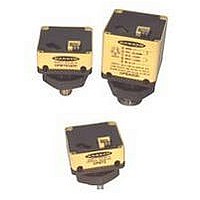OPBT2QD BANNER ENGINEERING, OPBT2QD Datasheet - Page 7

OPBT2QD
Manufacturer Part Number
OPBT2QD
Description
Proximity Sensor
Manufacturer
BANNER ENGINEERING
Datasheet
1.OPBT2QD.pdf
(12 pages)
Specifications of OPBT2QD
Leaded Process Compatible
No
Peak Reflow Compatible (260 C)
No
Supply Voltage Max
30VDC
Switch Terminals
Quick Connect
Supply Voltage Min
10VDC
Operating Temperature Min
-40°C
Operating Temperature Max
70°C
Sensor Output
NPN/PNP
Figure 8. Dark condition example:
Figure 9. Light condition example:
D.A.T.A. system LEDs #1
and #2 lit.
D.A.T.A. system LEDs
#1 through #8 lit.
Contrast is the ratio of the amount of light falling on the receiver in the “light” state,
compared to the “dark” state (sometimes called “light-to-dark ratio”). Optimizing the
contrast in any sensing situation increases the sensing reliability. Contrast may be
calculated if excess gain values are known for both the light and dark conditions:
To determine the contrast for any sensing application, present both the Light and Dark
conditions to the OMNI-BEAM, and note how many LEDs in the D.A.T.A. display are
ON for each condition. Compute the ratio from the corresponding excess gain
numbers (from the chart on page 6) for the two conditions.
For example, if LEDs #1 through #8 come ON in the Light condition and LEDs #1 and
#2 come ON in the Dark condition (assuming Standard scale factor), contrast is
calculated as follows:
This value is expressed as 6:1 (“six-to-one”).
The best sensor adjustment will cause all ten D.A.T.A. LEDs to come ON for the Light
condition, and none in the Dark condition. In this situation (such as an application in
which a box breaks the beam of an opposed-mode emitter/receiver pair):
While it is not always possible to adjust a sensor to maintain this much contrast, it is
important to always adjust for the maximum possible contrast. The D.A.T.A. feature
makes this easy. The chart below gives general guidelines for contrast values.
Measuring Sensing Contrast
1.2 or Less
1.2 to 2
2 to 3
3 to 10
10 or Greater
Contrast
Contrast = Excess gain (light condition)
Light condition: 2.2x excess gain
Dark condition: 0.35x excess gain
Contrast is greater than
Contrast = 2.2x = 6
Contrast Values and Corresponding Guidelines
Excess gain (dark condition)
Unreliable. Evaluate alternative sensing schemes.
Poor Contrast. Use the LOW hysteresis setting and the FINE
Low Contrast. Sensing environment must remain perfectly clean and
Good Contrast. Minor sensing system variables will not affect
Excellent Contrast. Sensing should remain reliable as long as the
0.35x
scale factor.
all other sensing variables must remain stable.
sensing reliabilty.
sensing system has enough excess gain for operation.
OMNI-BEAM Sensor Heads
0.25x
3.7x
= 15
Recommendation
page
7















